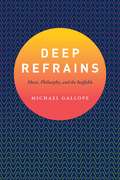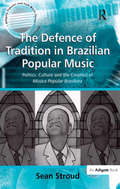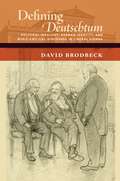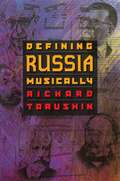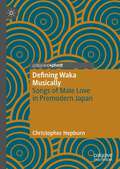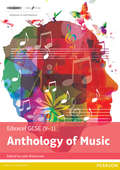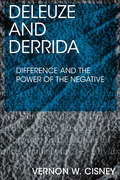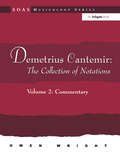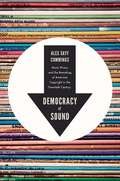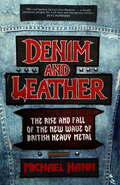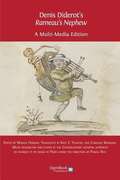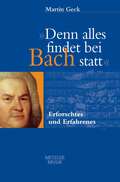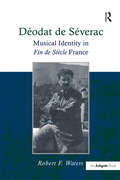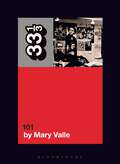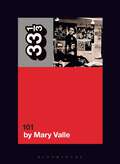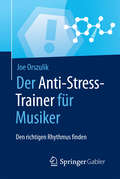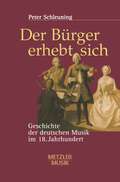- Table View
- List View
Deep Refrains: Music, Philosophy, and the Ineffable
by Michael GallopeWe often say that music is ineffable, that it does not refer to anything outside of itself. But if music, in all its sensuous flux, does not mean anything in particular, might it still have a special kind of philosophical significance? In Deep Refrains, Michael Gallope draws together the writings of Arthur Schopenhauer, Friedrich Nietzsche, Ernst Bloch, Theodor Adorno, Vladimir Jankélévitch, Gilles Deleuze, and Félix Guattari in order to revisit the age-old question of music’s ineffability from a modern perspective. For these nineteenth- and twentieth-century European philosophers, music’s ineffability is a complex phenomenon that engenders an intellectually productive sense of perplexity. Through careful examination of their historical contexts and philosophical orientations, close attention to their use of language, and new interpretations of musical compositions that proved influential for their work, Deep Refrains forges the first panoptic view of their writings on music. Gallope concludes that music’s ineffability is neither a conservative phenomenon nor a pious call to silence. Instead, these philosophers ask us to think through the ways in which music’s stunning force might address, in an ethical fashion, intricate philosophical questions specific to the modern world.
Deep Refrains: Music, Philosophy, and the Ineffable
by Michael GallopeWe often say that music is ineffable, that it does not refer to anything outside of itself. But if music, in all its sensuous flux, does not mean anything in particular, might it still have a special kind of philosophical significance? In Deep Refrains, Michael Gallope draws together the writings of Arthur Schopenhauer, Friedrich Nietzsche, Ernst Bloch, Theodor Adorno, Vladimir Jankélévitch, Gilles Deleuze, and Félix Guattari in order to revisit the age-old question of music’s ineffability from a modern perspective. For these nineteenth- and twentieth-century European philosophers, music’s ineffability is a complex phenomenon that engenders an intellectually productive sense of perplexity. Through careful examination of their historical contexts and philosophical orientations, close attention to their use of language, and new interpretations of musical compositions that proved influential for their work, Deep Refrains forges the first panoptic view of their writings on music. Gallope concludes that music’s ineffability is neither a conservative phenomenon nor a pious call to silence. Instead, these philosophers ask us to think through the ways in which music’s stunning force might address, in an ethical fashion, intricate philosophical questions specific to the modern world.
Deep Refrains: Music, Philosophy, and the Ineffable
by Michael GallopeWe often say that music is ineffable, that it does not refer to anything outside of itself. But if music, in all its sensuous flux, does not mean anything in particular, might it still have a special kind of philosophical significance? In Deep Refrains, Michael Gallope draws together the writings of Arthur Schopenhauer, Friedrich Nietzsche, Ernst Bloch, Theodor Adorno, Vladimir Jankélévitch, Gilles Deleuze, and Félix Guattari in order to revisit the age-old question of music’s ineffability from a modern perspective. For these nineteenth- and twentieth-century European philosophers, music’s ineffability is a complex phenomenon that engenders an intellectually productive sense of perplexity. Through careful examination of their historical contexts and philosophical orientations, close attention to their use of language, and new interpretations of musical compositions that proved influential for their work, Deep Refrains forges the first panoptic view of their writings on music. Gallope concludes that music’s ineffability is neither a conservative phenomenon nor a pious call to silence. Instead, these philosophers ask us to think through the ways in which music’s stunning force might address, in an ethical fashion, intricate philosophical questions specific to the modern world.
The Defence of Tradition in Brazilian Popular Music: Politics, Culture and the Creation of Música Popular Brasileira (Ashgate Popular and Folk Music Series)
by Sean StroudSean Stroud examines how and why Música Popular Brasileira (MPB) has come to have such a high status, and why the musical tradition (including MPB) within Brazil has been defended with such vigour for so long. He emphasizes the importance of musical nationalism as an underlying ideology to discussions about Brazilian popular music since the 1920s, and the key debate on so-called 'cultural invasion' in Brazil. The roles of those responsible for the construction of the idea of MPB are examined in detail. Stroud analyses the increasingly close relationship that has developed between television and popular music in Brazil with particular reference to the post-1972 televised song festivals. He goes on to consider the impact of the Brazilian record industry in the light of theories of cultural imperialism and globalization and also evaluates governmental intervention relating to popular music in the 1970s. The importance of folklore and tradition in popular music that is present in both Mário de Andrade and Marcus Pereira's efforts to 'musically map' Brazil is clearly emphasized. Stroud contrasts these two projects with Hermano Vianna and Itaú Cultural's similar ventures at the end of the twentieth century that took a totally different view of musical 'authenticity' and tradition. Stroud concludes that the defence of musical traditions in Brazil is inextricably bound up with nationalistic sentiments and a desire to protect and preserve. MPB is the musical expression of the Brazilian middle class and has traditionally acted as a cultural icon because it is associated with notions of 'quality' by certain sectors of the media.
The Defence of Tradition in Brazilian Popular Music: Politics, Culture and the Creation of Música Popular Brasileira (Ashgate Popular and Folk Music Series)
by Sean StroudSean Stroud examines how and why Música Popular Brasileira (MPB) has come to have such a high status, and why the musical tradition (including MPB) within Brazil has been defended with such vigour for so long. He emphasizes the importance of musical nationalism as an underlying ideology to discussions about Brazilian popular music since the 1920s, and the key debate on so-called 'cultural invasion' in Brazil. The roles of those responsible for the construction of the idea of MPB are examined in detail. Stroud analyses the increasingly close relationship that has developed between television and popular music in Brazil with particular reference to the post-1972 televised song festivals. He goes on to consider the impact of the Brazilian record industry in the light of theories of cultural imperialism and globalization and also evaluates governmental intervention relating to popular music in the 1970s. The importance of folklore and tradition in popular music that is present in both Mário de Andrade and Marcus Pereira's efforts to 'musically map' Brazil is clearly emphasized. Stroud contrasts these two projects with Hermano Vianna and Itaú Cultural's similar ventures at the end of the twentieth century that took a totally different view of musical 'authenticity' and tradition. Stroud concludes that the defence of musical traditions in Brazil is inextricably bound up with nationalistic sentiments and a desire to protect and preserve. MPB is the musical expression of the Brazilian middle class and has traditionally acted as a cultural icon because it is associated with notions of 'quality' by certain sectors of the media.
Defining Deutschtum: Political Ideology, German Identity, and Music-Critical Discourse in Liberal Vienna (New Cultural History of Music)
by David BrodbeckDefining Deutschtum: Political Ideology, German Identity, and Music-Critical Discourse in Liberal Vienna offers a nuanced look at the intersection of music, cultural identity, and political ideology in late-nineteenth-century Vienna. Drawing on an extensive selection of writings in the city's political press, correspondence, archival documents, and a large body of recent scholarship in late Habsburg cultural and political history, author David Brodbeck argues that Vienna's music critics were important agents in the public sphere whose writings gave voice to distinct, sometimes competing ideological positions. These conflicting positions are exemplified especially well in their critical writings about the music of three notable composers of the day who were Austrian citizens but not ethnic Germans: Carl Goldmark, a Jew from German West Hungary, and the Czechs Bed?ich Smetana and Antonín Dvo?ák. Often at stake in the critical discourse was the question of who and what could be deemed "German" in the multinational Austrian state. For critics such as Eduard Hanslick and Ludwig Speidel, traditional German liberals who came of age in the years around 1848, "Germanness" was an attribute that could be earned by any ambitious bourgeois-including Jews and those of non-German nationality-by embracing German cultural values. The more nationally inflected liberalism evident in the writings of Theodor Helm, with its particularist rhetoric of German national property in a time of Czech gains at German expense, was typical of those in the next generation, educated during the 1860s. The radical student politics of the 1880s, with its embrace of racialist antisemitism and irredentist German nationalism, just as surely shaped the discourse of certain young Wagnerian critics who emerged at the end of the century. This body of music-critical writing reveals a continuum of exclusivity, from a conception of Germanness rooted in social class and cultural elitism to one based in blood. Brodbeck neatly counters decades of musicological scholarship and offers a unique insight into the diverse ways in which educated German Austrians conceived of Germanness in music and understood their relationship to their non-German fellow citizens. Defining Deutschtum is sure to be an essential text for scholars of music history, cultural studies, and late 19th century Central European culture and society.
Defining Russia Musically: Historical and Hermeneutical Essays
by Richard TaruskinThe world-renowned musicologist Richard Taruskin has devoted much of his career to helping listeners appreciate Russian and Soviet music in new and sometimes controversial ways. Defining Russia Musically represents one of his landmark achievements: here Taruskin uses music, together with history and politics, to illustrate the many ways in which Russian national identity has been constructed, both from within Russia and from the Western perspective. He contends that it is through music that the powerful myth of Russia's "national character" can best be understood. Russian art music, like Russia itself, Taruskin writes, has "always [been] tinged or tainted ... with an air of alterity--sensed, exploited, bemoaned, reveled in, traded on, and defended against both from within and from without." The author's goal is to explore this assumption of otherness in an all-encompassing work that re-creates the cultural contexts of the folksong anthologies of the 1700s, the operas, symphonies, and ballets of the 1800s, the modernist masterpieces of the 1900s, and the hugely fraught but ambiguous products of the Soviet period. Taruskin begins by showing how enlightened aristocrats, reactionary romantics, and the theorists and victims of totalitarianism have variously fashioned their vision of Russian society in musical terms. He then examines how Russia as a whole shaped its identity in contrast to an "East" during the age of its imperialist expansion, and in contrast to two different musical "Wests," Germany and Italy, during the formative years of its national consciousness. The final section, expanded from a series of Christian Gauss seminars presented at Princeton in 1993, focuses on four individual composers, each characterized both as a self-consciously Russian creator and as a European, and each placed in perspective within a revealing hermeneutic scheme. In the culminating chapters--Chaikovsky and the Human, Scriabin and the Superhuman, Stravinsky and the Subhuman, and Shostakovich and the Inhuman--Taruskin offers especially thought-provoking insights, for example, on Chaikovsky's status as the "last great eighteenth-century composer" and on Stravinsky's espousal of formalism as a reactionary, literally counterrevolutionary move.
Defining Waka Musically: Songs of Male Love in Premodern Japan
by Christopher HepburnThis book considers how music, musicality, and ideologies of musicality are working within the specific construction of waka on the theme of male love in Kitamura Kigin’s Iwatsutsuji (1676) and Ihara Saikaku’s Nanshoku ōkagami (1687) by using a modified generative theory of music. This modified theory seeks to get at the interdependent meanings that may exist among the music, image, and the text of the waka in question. In all, this study guides the reader through five waka on the theme of male love and demonstrates not only how each waka is inherently musical but how the image and text may interdependently relate to the ways in which premodern Japanese song poets may not only have thought in and with sound but may have also utilized a diverse array of musical gestures to construct new objects of knowledge. In the case of this study, these new objects of knowledge seem to have aided in situating a changing musicopoetics that aligned with changing constructions of male desire.
Defying Gravity (PDF)
by SchwartzSet work score for Edexcel/Pearson GCSE Music from 2016. Part of a multi-media version. Braille music and audio available from mas@rnib.org.uk
Deleuze and Derrida: Difference and the Power of the Negative
by Vernon W. CisneyExamines independent documentary film production in India within a political context
Deleuze and Derrida: Difference and the Power of the Negative
by Vernon W. CisneyA reassessment of the film musical post-2000
Demetrius Cantemir: Volume 2: Commentary
by Owen WrightThe substantial collection of notations of seventeenth-century Ottoman instrumental music made by Demetrius Cantemir is both a record of compositions of considerable intrinsic interest and a historical document of vital importance, representing as it does one of the most comprehensive accounts of any Middle Eastern repertoire before the widespread adoption of Western notation in the twentieth century. This volume contains a commentary to the edition of Cantemir's notations prepared by the same author. The introductory section provides a context for the collection, giving a biographical sketch of its compiler and relating it to the theoretical treatise it accompanies. This is followed by a substantial analysis of modal structures which examines each makam individually and then attempts to make progressively wider generalizations. The projection of melody onto the various rhythmic cycles is next examined, with particular attention being paid to the various formulaic elements which constitute much of the compositional language of the period. A final section shifts to a more diachronic perspective, surveying internal evidence for historical change and for the survival of earlier styles.
Demetrius Cantemir: Volume 2: Commentary
by Owen WrightThe substantial collection of notations of seventeenth-century Ottoman instrumental music made by Demetrius Cantemir is both a record of compositions of considerable intrinsic interest and a historical document of vital importance, representing as it does one of the most comprehensive accounts of any Middle Eastern repertoire before the widespread adoption of Western notation in the twentieth century. This volume contains a commentary to the edition of Cantemir's notations prepared by the same author. The introductory section provides a context for the collection, giving a biographical sketch of its compiler and relating it to the theoretical treatise it accompanies. This is followed by a substantial analysis of modal structures which examines each makam individually and then attempts to make progressively wider generalizations. The projection of melody onto the various rhythmic cycles is next examined, with particular attention being paid to the various formulaic elements which constitute much of the compositional language of the period. A final section shifts to a more diachronic perspective, surveying internal evidence for historical change and for the survival of earlier styles.
Democracy of Sound: Music Piracy and the Remaking of American Copyright in the Twentieth Century
by Alex Sayf CummingsIt was a time when music fans copied and traded recordings without permission. An outraged music industry pushed Congress to pass anti-piracy legislation. Yes, that time is now; it was also the era of Napster in the 1990s, of cassette tapes in the 1970s, of reel-to-reel tapes in the 1950s, even the phonograph epoch of the 1930s. Piracy, it turns out, is as old as recorded music itself. In Democracy of Sound, Alex Sayf Cummings uncovers the little-known history of music piracy and its sweeping effects on the definition of copyright in the United States. When copyright emerged, only visual material such as books and maps were thought to deserve protection; even musical compositions were not included until 1831. Once a performance could be captured on a wax cylinder or vinyl disc, profound questions arose over the meaning of intellectual property. Is only a written composition defined as a piece of art? If a singer performs a different interpretation of a song, is it a new and distinct work? Such questions have only grown more pressing with the rise of sampling and other forms of musical pastiche. Indeed, music has become the prime battleground between piracy and copyright. It is compact, making it easy to copy. And it is highly social, shared or traded through social networks--often networks that arise around music itself. But such networks also pose a counter-argument: as channels for copying and sharing sounds, they were instrumental in nourishing hip-hop and other new forms of music central to American culture today. Piracy is not always a bad thing. An insightful and often entertaining look at the history of music piracy, Democracy of Sound offers invaluable background to one of the hot-button issues involving creativity and the law.
Democracy of Sound: Music Piracy and the Remaking of American Copyright in the Twentieth Century
by Alex Sayf CummingsIt was a time when music fans copied and traded recordings without permission. An outraged music industry pushed Congress to pass anti-piracy legislation. Yes, that time is now; it was also the era of Napster in the 1990s, of cassette tapes in the 1970s, of reel-to-reel tapes in the 1950s, even the phonograph epoch of the 1930s. Piracy, it turns out, is as old as recorded music itself. In Democracy of Sound, Alex Sayf Cummings uncovers the little-known history of music piracy and its sweeping effects on the definition of copyright in the United States. When copyright emerged, only visual material such as books and maps were thought to deserve protection; even musical compositions were not included until 1831. Once a performance could be captured on a wax cylinder or vinyl disc, profound questions arose over the meaning of intellectual property. Is only a written composition defined as a piece of art? If a singer performs a different interpretation of a song, is it a new and distinct work? Such questions have only grown more pressing with the rise of sampling and other forms of musical pastiche. Indeed, music has become the prime battleground between piracy and copyright. It is compact, making it easy to copy. And it is highly social, shared or traded through social networks--often networks that arise around music itself. But such networks also pose a counter-argument: as channels for copying and sharing sounds, they were instrumental in nourishing hip-hop and other new forms of music central to American culture today. Piracy is not always a bad thing. An insightful and often entertaining look at the history of music piracy, Democracy of Sound offers invaluable background to one of the hot-button issues involving creativity and the law.
Denes Agay's Learning To Play Piano - Book 1 (PDF)
by Denes Agay(Yorktown). A progression of melodic pieces and studies teaching the basics step by step. A fresh, unhurried and sound approach to piano study. It offers a veritable treasure of delightfully melodic, inventive repertoire to illustrate and correlate technique, theory, and musicianship.
Denim and Leather: The Rise and Fall of the New Wave of British Heavy Metal
by Michael HannIn the late 1970s, aggressive, young bands are forming across Britain. Independent labels are springing up to release their music. But this isn't the story of punk. Forget punk. Punk was a flash in the pan compared to this. This is the story of the New Wave of British Heavy Metal, a musical movement that changed the world. From this movement - given the unwieldy acronym NWOBHM - sprang streams that would flow through metal's subsequent development. Without NWOBHM there is no thrash metal, no death metal, no black metal. Without the rise of Iron Maiden, NWOBHM's standard bearers, leading the charge to South America and to South Asia, metal's global spread is slower. Without the NWOBHM bands - who included Def Leppard, Motorhead, Judas Priest, Diamond Head and many others - the international uniform of heavy metal - the 'battle jacket' of a denim jacket with sleeves ripped off, and covered with patches (usually sewn on by the wearer's mum), worn over a leather biker jacket - does not exist: 'Denim and leather brought us all together,' as Saxon put it.No book has ever gathered together all the principals of British heavy rock's most fertile period: Jimmy Page, Rick Allen, Michael Schenker, Robert John 'Mutt' Lange, Ritchie Blackmore, Rick Savage, Phil Collen, David Coverdale, Cronos, Biff Byford, Joe Elliott, Rob Halford, Ian Gillan, Phil Mogg, Robert Plant, Tony Wilson, Lars Ulrich, Pete Waterman to name a few.In Denim and Leather, these stars tell their own stories - their brilliant, funny tales of hubris and disaster, of ambition and success - and chart how, over a handful of years from the late 1970s to the early 1980s, a group of unlikely looking blokes from the provinces wearing spandex trousers changed heavy music forever.This is the definitive story about the greatest days of British heavy rock.
Denis Diderot’s Rameau’s Nephew: A Multi-Media Edition (PDF)
by Marian Hobson Kate E. Tunstall Caroline Warman Pascal Duc Conservatoire national supérieur de musique et de danse de ParisIn a famous Parisian chess café, a down-and-out, HIM, accosts a former acquaintance, ME, who has made good, more or less. They talk about chess, about genius, about good and evil, about music, they gossip about the society in which they move, one of extreme inequality, of corruption, of envy, and about the circle of hangers-on in which the down-and-out abides. The down-and-out from time to time is possessed with movements almost like spasms, in which he imitates, he gestures, he rants. And towards half past five, when the warning bell of the Opera sounds, they part, going their separate ways. Probably completed in 1772-73, Denis Diderot's Rameau's Nephew fascinated Goethe, Hegel, Engels and Freud in turn, achieving a literary-philosophical status that no other work by Diderot shares. This interactive, multi-media, colour edition offers a brand new translation of Diderot's famous dialogue, and it also gives the reader much more. Portraits and biographies of the numerous individuals mentioned in the text, from minor actresses to senior government officials, enable the reader to see the people Diderot describes, and provide a window onto the complex social and political context that forms the backdrop to the dialogue. Links to musical pieces specially selected by Pascal Duc and performed by students of the Conservatoire national supérieur de musique, Paris, illuminate the wider musical context of the work, enlarging it far beyond its now widely understood relation to opéra comique.
"Denn alles findet bei Bach statt": Erforschtes und Erfahrenes
by Martin GeckDas flüssig geschriebene Buch informiert über den aktuellen Stand der Bach-Forschung.
Déodat de Séverac: Musical Identity in Fin de Siècle France
by RobertF. WatersD�at de S�rac (1872-1921) is best known for his piano music but his compositions included orchestral and vocal works, including opera, cantata and incidental music. Claude Debussy described S�rac's music as "exquisite and rich with ideas." The early works were influenced by Impressionist harmonies, church modes, cyclic techniques, folk-like melodies and Andalusian motives. S�rac's style changed dramatically in 1907 when he left Paris and began to include Catalan elements in his compositions - a transition that has hitherto gone unrecognized. Robert Waters provides a much-needed study of the life and works of S�rac, focusing on the composer's regionalist philosophy. S�rac's engagement with folk music was not a patriotic gesture in the vein of nationalistic composers, but a way of expressing regional identity within France to counter the restrictive styles sanctioned by the Paris Conservatory. His musical philosophy mirrored larger social and political debates regarding anti-centralist positions on education, politics, art and culture in fin de siecle France. Such debates involved political and social leaders whom S�rac knew and personally admired, including the writer Maurice Barr�and the poet Fr�ric Mistral. The book will appeal to those specializing in French music, European ethnic musics, piano music and French music history.
Déodat de Séverac: Musical Identity in Fin de Siècle France
by RobertF. WatersD�at de S�rac (1872-1921) is best known for his piano music but his compositions included orchestral and vocal works, including opera, cantata and incidental music. Claude Debussy described S�rac's music as "exquisite and rich with ideas." The early works were influenced by Impressionist harmonies, church modes, cyclic techniques, folk-like melodies and Andalusian motives. S�rac's style changed dramatically in 1907 when he left Paris and began to include Catalan elements in his compositions - a transition that has hitherto gone unrecognized. Robert Waters provides a much-needed study of the life and works of S�rac, focusing on the composer's regionalist philosophy. S�rac's engagement with folk music was not a patriotic gesture in the vein of nationalistic composers, but a way of expressing regional identity within France to counter the restrictive styles sanctioned by the Paris Conservatory. His musical philosophy mirrored larger social and political debates regarding anti-centralist positions on education, politics, art and culture in fin de siecle France. Such debates involved political and social leaders whom S�rac knew and personally admired, including the writer Maurice Barr�and the poet Fr�ric Mistral. The book will appeal to those specializing in French music, European ethnic musics, piano music and French music history.
Depeche Mode's 101 (33 1/3)
by Mary ValleDepeche Mode's 101 is, at first glance, a curious thing: a live double-album by a synth band. A recording of its “Concert for the Masses,” 101 marks the moment when doomy, cultish, electronic Depeche Mode, despite low American album sales and a lack of critical acclaim, declared they had arrived and ascended to the rare air of stadium rock. On June 18, 1988, 65,000 screaming, singing Southern Californians flocked to Pasadena's Rose Bowl to celebrate DM's coronation. The concert also revealed the power of Southern California radio station and event host KROQ, which had turned Los Angeles into DM's American stronghold through years of fervent airplay. KROQ's innovative format, which brought “new music” to its avid listeners, soon spread across the country, leading to the explosion of alternative rock in the 1990s.Eight years after its founding in Basildon, Essex, Depeche Mode, rooted in 1970s Krautrock, combined old-fashioned touring, well-crafted songs, and the steadfast support of KROQ to dominate Southern California, the United States, and then the world, kicking open the doors for the likes of Nirvana in the process. 101 is the hidden-in-plain-sight hinge of modern music history.
Depeche Mode's 101 (33 1/3)
by Mary ValleDepeche Mode's 101 is, at first glance, a curious thing: a live double-album by a synth band. A recording of its “Concert for the Masses,” 101 marks the moment when doomy, cultish, electronic Depeche Mode, despite low American album sales and a lack of critical acclaim, declared they had arrived and ascended to the rare air of stadium rock. On June 18, 1988, 65,000 screaming, singing Southern Californians flocked to Pasadena's Rose Bowl to celebrate DM's coronation. The concert also revealed the power of Southern California radio station and event host KROQ, which had turned Los Angeles into DM's American stronghold through years of fervent airplay. KROQ's innovative format, which brought “new music” to its avid listeners, soon spread across the country, leading to the explosion of alternative rock in the 1990s.Eight years after its founding in Basildon, Essex, Depeche Mode, rooted in 1970s Krautrock, combined old-fashioned touring, well-crafted songs, and the steadfast support of KROQ to dominate Southern California, the United States, and then the world, kicking open the doors for the likes of Nirvana in the process. 101 is the hidden-in-plain-sight hinge of modern music history.
Der Anti-Stress-Trainer für Musiker: Den richtigen Rhythmus finden
by Joe Orszulik Peter BuchenauDieses Buch aus der Anti-Stress-Trainer-Reihe thematisiert das Leben und die Stressfaktoren von Musikerinnen und Musikerin. Zahllose Musiker, Instrumentallehrer, Musikpädagogen, Komponisten und auch Textschreiber, die allermeist sehr euphorisch in ihre Karriere starten, sind schon bald desillusioniert, erschöpft oder leiden sogar unter Burnout. Gründe dafür sind unter anderem eine unsichere finanzielle Position, unregelmäßige Arbeitszeiten und auch eine starke körperliche Belastung. Dieses Buch informiert die Leser nicht nur über das Thema Stress bei Musikern, sondern gibt gleichzeitig viele hilfreiche Praxistipps für einen gesunden und erfolgreichen Umgang mit Stress. Der Autor, der selbst jahrelang aktiver Musiker war, gibt seine Erfahrungen und sein Wissen in diesem Buch weiter.
Der Bürger erhebt sich: Geschichte der deutschen Musik im 18. Jahrhundert
by Peter SchleuningDie neu gewonnene Freiheit. Von diesem radikalen Wandel in der Musikausübung, aber auch von den Schwierigkeiten und Neuerungen der Komponisten der Bach-Generation und der beginnenden Klassik erzählt Schleunings Werk anhand zeitgenössischer Quellen und daran anknüpfender Überlegungen. Auf diese Weise entsteht eine farbige und facettenreiche Stil- und Sozialgeschichte des Übergangs von der feudalen Hofkunst zum anonymen bürgerlichen Markt.
